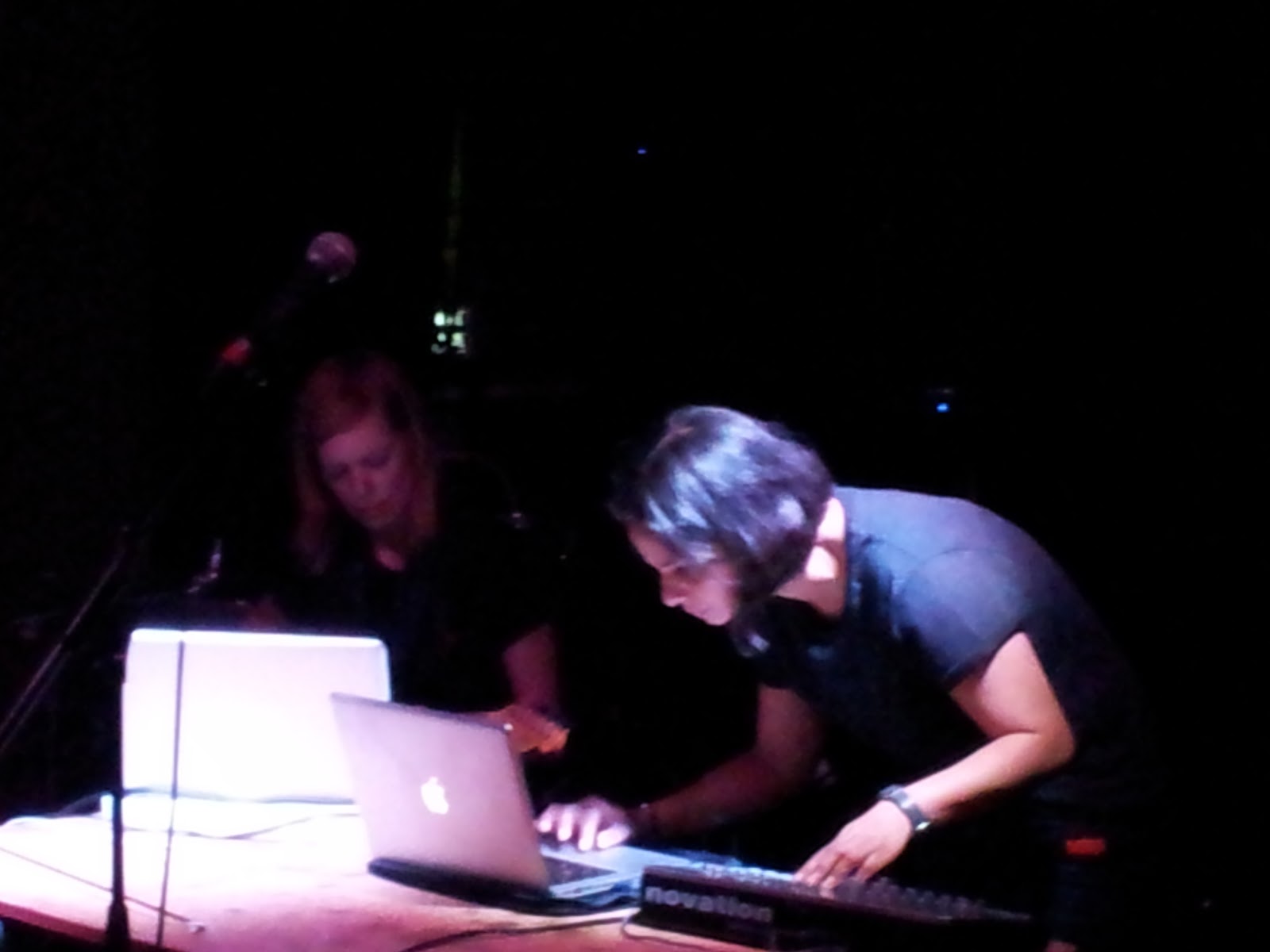Saturday, 27 October 2012
Digbeth Drama
Supersonic is again a brave festival proposition, removing the obvious rock and alternative crutches of the mass sing-a-long or worshipful archive grave-robbing, and relying on the hypnotick and primitive power of its forms to keep the audience from chin-stroking nerd-dom. We saw some properly cracking stuff, topped by Richard Dawson, an unprepossessing bearded Northerner, with a ululating wail of a voice and a tear-jerking way with a folk story. A gob-smacking sequence of key-changes as he worked his way through "Poor Old Horse" (a simple but affecting tale of the botched execution of aforementioned equine) were as powerful a musical device as we heard amid all the laptops and tone generators. His gag about being surrounded by the ghosts of various grandparents and pets, playing as his backing band, was the funniest thing we heard all weekend, outside of the dare-you-to-laugh "Black Star" refrain that Modified Toy Orchestra deployed.
There wasn't great deal of real onstage charisma if truth be told, though what there was, was electrifying. Jarboe, for me, has been a spectral presence known only from the "Burning World" Swans LP and the terrifying "Anhedoniac". She took the very simple but appallingly effective route of just standing onstage and singing the songs; with the eye-rolling and entranced delivery she has, this was more than enough to grip. There are matter-of-fact lyrical gestures towards barely-imaginable torment and heart-stopping devotion, which Jarboe can deliver like a public service announcement.
Rock is a tired and tiresome form, so needs something de-stabilising to jolt it beyond cheesy posturing (yes, Six Organs of Admittance, I'm talking about you). The babyish and fraught contortions of the Doomsday Student (bad name, good idea) vocalist was the only convincing rock stage incarnation of the weekend. He gibbered, plucked, arched, grasped and groped while the band delivered a harsh traumatised punk rock, knowingly stylised and sleekly aerodynamic.
The finale was well-chosen by the curators; I only know Oxbow from barely-comprehensible inky reports of muscular performative confrontation. On this evidence, they've had criminally poor coverage: a stark and rhythmic string section gives the declamatory and distressed vocal plenty of room to manoevre, the gasps and guttural groans in the delivery all too close for comfort.
Camera Angle

 These are two gloriously cinematic films, that certainly wouldn't have justice done to them on a television screen. Andrea Arnold puts an astonishing weather-beaten array of natural greens, greys and russets into the frame, and even squares off the frame itself to heighten the sense of claustrophobia and to avoid opening up the film to an easily-delivered vista-of-nature. Her camera follows Heathcliff from beating to hillside to stable, punctuating the barely-imaginable journey Arnold charts for him, from act of charity, to dark obverse, to return of the repressed, with sudden, harsh, raw panoramas.
These are two gloriously cinematic films, that certainly wouldn't have justice done to them on a television screen. Andrea Arnold puts an astonishing weather-beaten array of natural greens, greys and russets into the frame, and even squares off the frame itself to heighten the sense of claustrophobia and to avoid opening up the film to an easily-delivered vista-of-nature. Her camera follows Heathcliff from beating to hillside to stable, punctuating the barely-imaginable journey Arnold charts for him, from act of charity, to dark obverse, to return of the repressed, with sudden, harsh, raw panoramas.
It was a crying shame that a gruesome pluck-fest of a track by Mumford and Sons was allowed to spray itself over the final few frames and reduce my memory of parts of the film to nothing better than an impressionistic folk music video styled by Toast's Moorland Farm aesthetic.
Lynne Ramsay (maker of the glorious Morvern Callar)
Baest Beats That
Baest were once again entrancing and categorically slippery at the Club Surya gig last week.
There are frequent very gentle eruptions of Persian-carpet noise and clattering thickets of percussion that lunge towards us and then scatter like startled gazelles. The tracks take the form of impressionistic live-action watercolours in deep and awkward colours: Acid Stomp, Electro Noise, and Disassembled Dance. Constantly and colourfully unclassifiable stuff.
Sunday, 7 October 2012
Tanked
We
saw Hito Steyerl, a Berlin based filmmaker, and Rabih Mroue, a Lebanese
artist, at the Tate Modern last night. Their double handed lecture was set in
one of the chilly Tank galleries, a raw and almost refridgerated space built
out of the previously derelict storage vats for power station oil. A very late
start, unimaginative powerpoints and a 90-minute duration were challenges that
my attention span was not up to meeting, unfortunately.
The essential ideas were very interesting:
What happens or has happened when there is ‘remaining’ probability, after all
the imaginable events have had their likelihood taken account of? Is there a
space where all the impossible people or statements are able to exist? Steyerl
and Mroue use some sleight of hand with storytelling, probability theory and
film editing to open this spatiality, without every completely convincing.
They are both very engaging performers and
artists (we particularly enjoyed Mroue’s “Pixelated Revolution” at dOCUMENTA,
featuring his quietly impassioned and clear-eyed commentary on mobile-phone
footage of police and army brutality, in which the user of the phone is shot
while filming), but perhaps needed a collaborator with a more pedagogical
style; the overall effect was of a presentation to the Tate curators for ideas
for a project that had not yet been fleshed out.
Subscribe to:
Posts (Atom)







